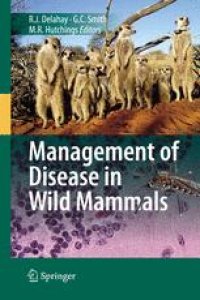
Ebook: Management of Disease in Wild Mammals
- Tags: Fish & Wildlife Biology & Management, Animal Ecology, Conservation Biology/Ecology, Veterinary Medicine, Zoology, Environmental Management
- Year: 2009
- Publisher: Springer Tokyo
- Edition: 1
- Language: English
- pdf
In recent years nobody could have failed to notice the frequent and often sensati- alist media headlines warning of the latest global disease threat to humankind. But behind all the hyperbole lie real challenges related to dealing with the increasing incidence of emerging zoonotic disease events, the majority of which are thought to originate in wildlife (Jones et al. 2008). There are also many important diseases of domestic livestock which also occur in wildlife (e. g. foot and mouth disease and classical swine fever in wild boar, bovine tuberculosis in deer, badgers or possums), some of which can have a devastating impact on the farming industry, the wider rural economy and ultimately the public purse. But we should also not forget that wildlife diseases may have serious implications for the conservation of biodiversity. For some of the rarest, most endangered species (such as the Ethiopian wolf) d- ease may pose the greatest threat to their survival. If we are to avoid or reduce these impacts then we must improve our ability to detect and manage the risks associated with disease in wildlife populations. This is a challenge that will require expertise from many different disciplines: veterinary, ecological, medical, economic, poli- cal and zoological. In such an interdisciplinary field it is difficult to stay up to date with contemporary ideas and with techniques that may be rapidly evolving.
Wildlife populations may be a significant source of infection for humans and domestic animals while in some cases being themselves endangered by pathogens. The development of sustainable approaches to the management of wildlife diseases is fundamental to the protection of human health, agriculture, and endangered species. Managing disease in free-ranging wild mammals presents serious challenges, however, because of their often complex ecology and social behavior, which can undermine simplistic assumptions about the dynamics of disease and responses to intervention. The text presents discussion of basic approaches to disease management, with reference to specific challenges presented by wild mammal populations and in the light of the results of recent research at the interfaces between disease epidemiology, host ecology, and wildlife management. Further chapters are devoted to surveillance, contingency planning, the application of mathematical models and cost-benefit analysis, and the special case of endangered species. This book provides an authoritative contemporary review of the major issues and challenges in the management of disease in wild mammals.
Wildlife populations may be a significant source of infection for humans and domestic animals while in some cases being themselves endangered by pathogens. The development of sustainable approaches to the management of wildlife diseases is fundamental to the protection of human health, agriculture, and endangered species. Managing disease in free-ranging wild mammals presents serious challenges, however, because of their often complex ecology and social behavior, which can undermine simplistic assumptions about the dynamics of disease and responses to intervention. The text presents discussion of basic approaches to disease management, with reference to specific challenges presented by wild mammal populations and in the light of the results of recent research at the interfaces between disease epidemiology, host ecology, and wildlife management. Further chapters are devoted to surveillance, contingency planning, the application of mathematical models and cost-benefit analysis, and the special case of endangered species. This book provides an authoritative contemporary review of the major issues and challenges in the management of disease in wild mammals.
Content:
Front Matter....Pages i-xiii
The Science of Wildlife Disease Management....Pages 1-8
Wildlife Population Structure and Parasite Transmission: Implications for Disease Management....Pages 9-29
Assessment of Transmission Rates and Routes, and the Implications for Management....Pages 31-51
Modelling Disease Dynamics and Management Scenarios....Pages 53-77
An Economic Perspective on Wildlife Disease Management....Pages 79-96
Options for the Control of Disease 1: Targeting the Infectious or Parasitic Agent....Pages 97-120
Options for the Control of Disease 2: Targeting Hosts....Pages 121-146
Options for the Control of Disease 3: Targeting the Environment....Pages 147-168
Risk Assessment and Contingency Planning for Exotic Disease Introductions....Pages 169-185
Wildlife Disease Surveillance and Monitoring....Pages 187-213
Disease Management in Endangered Mammals....Pages 215-239
Back Matter....Pages 241-284
Wildlife populations may be a significant source of infection for humans and domestic animals while in some cases being themselves endangered by pathogens. The development of sustainable approaches to the management of wildlife diseases is fundamental to the protection of human health, agriculture, and endangered species. Managing disease in free-ranging wild mammals presents serious challenges, however, because of their often complex ecology and social behavior, which can undermine simplistic assumptions about the dynamics of disease and responses to intervention. The text presents discussion of basic approaches to disease management, with reference to specific challenges presented by wild mammal populations and in the light of the results of recent research at the interfaces between disease epidemiology, host ecology, and wildlife management. Further chapters are devoted to surveillance, contingency planning, the application of mathematical models and cost-benefit analysis, and the special case of endangered species. This book provides an authoritative contemporary review of the major issues and challenges in the management of disease in wild mammals.
Content:
Front Matter....Pages i-xiii
The Science of Wildlife Disease Management....Pages 1-8
Wildlife Population Structure and Parasite Transmission: Implications for Disease Management....Pages 9-29
Assessment of Transmission Rates and Routes, and the Implications for Management....Pages 31-51
Modelling Disease Dynamics and Management Scenarios....Pages 53-77
An Economic Perspective on Wildlife Disease Management....Pages 79-96
Options for the Control of Disease 1: Targeting the Infectious or Parasitic Agent....Pages 97-120
Options for the Control of Disease 2: Targeting Hosts....Pages 121-146
Options for the Control of Disease 3: Targeting the Environment....Pages 147-168
Risk Assessment and Contingency Planning for Exotic Disease Introductions....Pages 169-185
Wildlife Disease Surveillance and Monitoring....Pages 187-213
Disease Management in Endangered Mammals....Pages 215-239
Back Matter....Pages 241-284
....